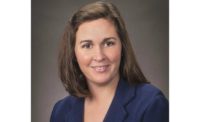Name: Caroline Traube
Age: 37
Title: P.E., ASHRAE BEMP, CEM, LED AP BD+C, senior building performance engineer, McKinstry
Educational Experience: Bachelor’s degree in civil engineering and a master’s degree in engineering, both from Stanford University.
Professional Credentials/Accreditations: P.E. in Colorado, ASHRAE BEMP, CEM, LEED AP BD+C.
What caused you to/when did you fall in love with engineering?
I always enjoyed math and science growing up. My interest was cemented my freshman year of college with a class titled “ME101: Visual Thinking.” The focus on rapid prototyping, collaboration, and problem-solving was appealing. While our group ultimately failed to land our egg (unharmed) into a box in the middle of a pond from a story up, the creative and challenging engineering process had me hooked.
What has been the most rewarding aspect of working in the skilled trades?
It’s rewarding to build trusted relationships with people throughout the building industry. People, not technology, get things done and having impact requires influencing others. Putting in the work to build that social capital to allow for meaningful contributions to projects is satisfying.
Describe the proudest moment in your career.
While I was working at Rocky Mountain Institute (RMI), I had the opportunity to work on the retrofit of the Empire State Building. RMI collaborated with other organizations to identify and implement innovative energy efficiency measures at a large scale on an iconic building in an economically viable way. The process we developed, and the verified energy savings of the project, created a powerful case study that helped drive a shift in the conversation around deep energy retrofits.
What challenges do women face in this profession? Can you give a personal example?
Women in engineering face challenges, including small networks, few role models, low expectations, and a history of exclusion. In a project-based industry, constantly working with new groups of people requires repeatedly reproving your value and competence, which becomes draining. Add personal life to the mix (we have a 1 year old and a 4 year old), and the day-to-day becomes a constant hustle. I’m lucky in that I have the backing to make it all easier — a company and team that feeds my passions, the ability to pay for great child care, and a supportive partner and family. Many women don’t have these same support systems and thus thriving (or surviving) at work isn’t as attainable.
I see positive change happening industry-wide through recruitment of more women, generational turnover, and workplace programs that focus on equity and inclusion. That said, I still attend many meetings as the only woman in the room, and I don’t see many women in the roles I hope to have one day. I’m hoping my generation will be one of the last to face this reality.
At McKinstry, I am on our corporate diversity advisory committee, and I also co-founded our now 40-member-strong technical women group focused on internal comradery, external networking, career advancement, corporate initiatives, and student outreach. This affinity group inspires me and others to build stronger relationships, advocate for one another, and mentor the next generation of women engineers — all needed threads to drive a more productive, innovative, and equitable building and construction industry.
What does your day-to-day job entail?
I lead a group of building performance analysts working to drive greater energy efficiency into the design and operation of buildings. We focus on building energy modeling, comfort/air quality studies, and daylighting analyses for high-performance, zero-energy, and zero-carbon buildings. As part of a small team within a larger engineering group, we all do some of everything including modeling work, quality control, standardization, strategic guidance, resource planning, and recruiting.
A passion of mine is ensuring the information we are generating is impacting decisions. To do this, we need to make the results of our engineering analyses graphical, easy to digest, and right-timed. Mentoring others in our organization to stay focused on answering specific questions in compelling, relatable ways is something I enjoy.
Ultimately, I try to ensure my team has access to the resources, tools, and training to excel in creating best-in-class, accurate, and informative deliverables for our clients. Our McKinstry engineering group’s ability to problem solve, keep it light, and be both empathetic and transparent with one another is key to our day-to-day productivity and collaboration.
What drives/motivates you every day?
In the big picture, I’ve always been motivated to work in energy efficiency and conservation because approaching the built environment through this lens creates a less wasteful, more conscientious way of existing in this world. It has always seemed like a sensible way to design and operate buildings. I’m also a type-three achiever, so I can’t help but be motivated to try to deliver high-quality results that make a lasting impression.
What remains on your engineering bucket list — what do you aspire to do that you haven’t accomplished yet?
I’d like to get more involved in the upstream process of creating aggressive codes and standards that truly put us on a path to address our climate crisis.
What’s one thing no one knows about you?
I was a collegiate NCAA All-American gymnast, competing in the all-around for the Stanford Women’s Gymnastics Team. There are few things in life like competing on the balance beam in front of 10,000 people that instill the criticality of skills like preparation, focus, and performance under pressure.
List any mentors who’ve helped you succeed and describe exactly how they’ve shaped your success.
Frank Lee was my gymnastics coach from age 9-18. As my (and others) “third parent,” he taught me how to set goals and carry on after failure. Most importantly, he made hard work fun.
Stephen Doig was a mentor of mine at RMI. As a brilliant, endlessly energetic systems-thinker, he taught me how to think logically, tell a powerful story, and set high standards.
Bryan Hanson was my first manager at McKinstry and convinced me I could learn how building systems work. He taught me to be self-reliant and to verify everything.
Michael Frank is a vice president of engineering at McKinstry. He is a problem solver, a do-gooder, and a gem of a human. I hope to be like him when I grow up.
I’ve also benefitted greatly from the advice and shared life experiences of numerous women peers and colleagues but through more informal conduits. A network of close female friends and family has also been invaluable in navigating career, kids, and relationships. Moving forward, I hope I can offer lasting and impactful mentorship to other women.
What advice do you have for prospective female engineers considering entering the field?
Great communication is an engineering (and general life) superpower. Also, it’s ok to not know the answer and to say so and to ask for help if you need it (you’d be surprised at how many people want you to succeed).




